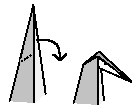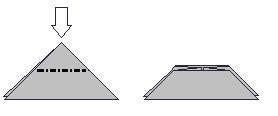Basic Folds
On this page I will show you the basic technics for Origami. Don't worry if you don't manage or understand how to do one of the following folds at once. After having folded some models you will know them all by heart. It's all a question of practise.
Valley Fold
 |
The valley fold is formed by folding the paper toward oneself. An arrow shows where to fold the piece of paper to.
Symbol: dashed line
Mountain Fold
 |
The mountain fold is formed by folding the paper away from oneself.
Symbol: alternating dashed and dotted line
Petal Fold
 |
The petal fold lifts a point and brings it upwards so that the two edges of the point lie together. It is best to prefold both layers of paper along the shown valley and mountain folds before making the petal fold.
The best example for this fold is the Birdbase.
Rabbit Ear Fold
 |
Prefold along the three valley folds first. Then fold the two sides down to the baseline (see arrows). Fold the top point to one side to make the mountain fold. (Take care that you fold the top point to the right side where the mountain fold is set.)
Squash Fold
 |
Prefold both sheets of paper along the valley and mountain fold. Then open the model, fold one layer of paper along the valley fold and flatten the model using the mountain fold.
The big white arrow tells you to open the model.
(Inside) Reverse Fold
 |
Prefold both sheets of paper in both directions (mountain and valley). Then open the model a little bit and bring the top point down so that the mountain fold edge becomes a valley fold edge.
Outside Reverse Fold
 |
It is similar to the inside reverse fold except the layers of the paper have to be wrapped around outside the point.
Crimp Fold
 |
A crimp is used as a way of incorporating two reverse folds to change the direction of a flap or point. In most cases it is easiest just to make two reverse folds one after the other (precrease both folds before).
The lines next to the image should show you how the layers lie after folding.
Sink Fold
 |
The sink fold is a method of blunting a point that has no open edges. The fold should first be precreased. Then carefully open the model and tuck the point inside. Flatten the model afterwards along existing creases.